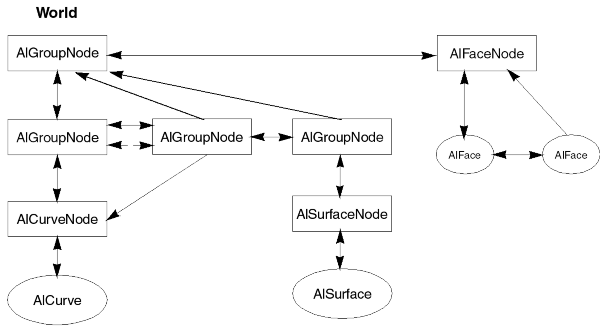The universe is a static class that can access all objects in a wire file or within Alias. The main feature of the universe is that it has a pointer to a tree-like data structure which is called a directed acyclic graph (DAG). All geometry, light, camera and cluster information is stored in this DAG. The DAG is composed of nodes called DAG nodes.

This diagram illustrates an example model. Arrows indicate that a class references the class that it is pointing to. Double sided arrows indicate a two way reference.
The topmost DAG node is called the “world”. In this example, the world node (returned by AlUniverse::firstDagNode()) has three group nodes as its “children” and an AlFaceNode as a sibling. Notice that the two group nodes below the topmost DAG node are instances. They both refer to the same curve node. NULL nodes (with nothing below them) created in the Alias interactive package are retrieved as AlDagNodes.
There are several classes derived from the DAG node class that refer to specific objects that contain geometry, light, camera, or cluster information. (When a DAG node “refers” to an object, it means that the DAG node has the object as a child object.) for example, a camera node is a DAG node that refers only to a camera object. A light node is a DAG node that refers only to a light object. Combinations such as these tend to be created at the same time, manipulated together, and deleted at the same time. Whenever a DAG node is created, it is inserted into the world position. After creating a DAG node, the method AlUniverse::firstDagNode() will return this node. Other creation routines (such as texture creation) can also insert nodes into the world position as the first node.